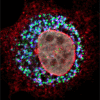Hepatitis C virus assembly imaging
- PMID: 22163343
- PMCID: PMC3230850
- DOI: 10.3390/v3112238
Hepatitis C virus assembly imaging
Abstract
Hepatitis C Virus (HCV) assembly process is the least understood step in the virus life cycle. The functional data revealed by forward and reverse genetics indicated that both structural and non-structural proteins are involved in the assembly process. Using confocal and electron microscopy different groups determined the subcellular localization of different viral proteins and they identified the lipid droplets (LDs) as the potential viral assembly site. Here, we aim to review the mechanisms that govern the viral proteins recruitment to LDs and discuss the current model of HCV assembly process. Based on previous examples, this review will also discuss advanced imaging techniques as potential means to extend our present knowledge of HCV assembly process.
Keywords: cellular imaging; hepatitis C virus; virus assembly.
Figures



Similar articles
-
A concerted action of hepatitis C virus p7 and nonstructural protein 2 regulates core localization at the endoplasmic reticulum and virus assembly.PLoS Pathog. 2011 Jul;7(7):e1002144. doi: 10.1371/journal.ppat.1002144. Epub 2011 Jul 21. PLoS Pathog. 2011. PMID: 21814513 Free PMC article.
-
Adaptive mutation F772S-enhanced p7-NS4A cooperation facilitates the assembly and release of hepatitis C virus and is associated with lipid droplet enlargement.Emerg Microbes Infect. 2018 Aug 8;7(1):143. doi: 10.1038/s41426-018-0140-z. Emerg Microbes Infect. 2018. PMID: 30087320 Free PMC article.
-
NS2 protein of hepatitis C virus interacts with structural and non-structural proteins towards virus assembly.PLoS Pathog. 2011 Feb 10;7(2):e1001278. doi: 10.1371/journal.ppat.1001278. PLoS Pathog. 2011. PMID: 21347350 Free PMC article.
-
Virion assembly and release.Curr Top Microbiol Immunol. 2013;369:199-218. doi: 10.1007/978-3-642-27340-7_8. Curr Top Microbiol Immunol. 2013. PMID: 23463202 Free PMC article. Review.
-
Cellular lipid droplets and hepatitis C virus life cycle.Biol Pharm Bull. 2010;33(3):355-9. doi: 10.1248/bpb.33.355. Biol Pharm Bull. 2010. PMID: 20190392 Review.
Cited by
-
In vivo models of hepatitis B and C virus infection.FEBS Lett. 2016 Jul;590(13):1987-99. doi: 10.1002/1873-3468.12157. Epub 2016 Apr 8. FEBS Lett. 2016. PMID: 27009462 Free PMC article. Review.
-
Interactions Between Hepatitis C Virus and Mitochondria: Impact on Pathogenesis and Innate Immunity.Curr Pathobiol Rep. 2013 Sep;1(3):179-187. doi: 10.1007/s40139-013-0024-9. Curr Pathobiol Rep. 2013. PMID: 23956955 Free PMC article.
-
Hepatitis C genotype 1 mosaic vaccines are immunogenic in mice and induce stronger T-cell responses than natural strains.Clin Vaccine Immunol. 2013 Feb;20(2):302-5. doi: 10.1128/CVI.00605-12. Epub 2012 Dec 5. Clin Vaccine Immunol. 2013. PMID: 23221002 Free PMC article.
-
Hepatitis C virus: virology and life cycle.Clin Mol Hepatol. 2013 Mar;19(1):17-25. doi: 10.3350/cmh.2013.19.1.17. Epub 2013 Mar 25. Clin Mol Hepatol. 2013. PMID: 23593605 Free PMC article. Review.
-
Direct acting antivirals for the treatment of chronic viral hepatitis.Scientifica (Cairo). 2012;2012:478631. doi: 10.6064/2012/478631. Epub 2012 Nov 25. Scientifica (Cairo). 2012. PMID: 24278700 Free PMC article. Review.
References
-
- Shepard C.W., Finelli L., Alter M.J. Global epidemiology of hepatitis C virus infection. Lancet Infect. Dis. 2005;5:558–567. - PubMed
-
- Lindenbach B.D., Thiel H.J., Rice C.M. Flaviviridae: The viruses and their replication. In: Knipe D.M., Howley P.M., editors. Fields Virology. 5th ed. Lippincott Williams & Wilkins; Philadelphia, PA, USA: 2007. pp. 1101–1152.
-
- Lohmann V., Korner F., Koch J., Herian U., Theilmann L., Bartenschlager R. Replication of subgenomic hepatitis C virus RNAs in a hepatoma cell line. Science. 1999;285:110–113. - PubMed
-
- Drummer H.E., Maerz A., Poumbourios P. Cell surface expression of functional hepatitis C virus e1 and e2 glycoproteins. FEBS Lett. 2003;546:385–390. - PubMed
Publication types
MeSH terms
Substances
LinkOut - more resources
Full Text Sources
Medical

